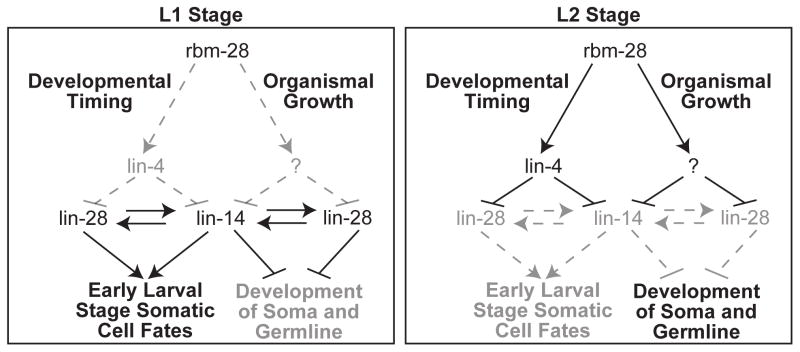Figure 6.
A model for the role of rbm-28 in the heterochronic and organismal growth pathways. In early L1, lin-4 miRNA is not present, allowing for the expression of LIN-14 and LIN-28 proteins, which promote early larval cell fates and repress organismal growth. By the L2 stage, lin-4 is expressed and stabilized by rbm-28, resulting in the down-regulation of lin-14 and lin-28 activity, which allows later larval stages and overall growth to proceed. This model is based on the findings that loss of rbm-28 or lin-4 results in retarded development of somatic tissues, such as the vulva and hypodermal seam cells. These phenotypes can be suppressed by down-regulation of the lin-4 target genes lin-14 and lin-28, which positively regulate each other and promote early larval cell fates. Depletion of rbm-28 also results in overall delayed growth, including the gonad. This phenotype is not observed in lin-4 mutants, but the rbm-28 RNAi induced growth delay is suppressed in lin-14 and lin-28 mutants, revealing new roles for lin-14 and lin-28 in coordinating overall organismal growth and development. In the organismal growth arm of the pathway, rbm-28 could directly repress lin-14 and lin-28 or their downstream targets to promote development. Although not sufficient, lin-4 activity also contributes to the organismal growth pathway when rbm-28 is depleted because deletion of lin-4 reestablishes delayed growth in the lin-14(n179) mutants. Alternatively, rbm-28 could positively regulate an upstream factor (indicated by the question mark), possibly a miRNA, that inhibits expression of lin-14 and lin-28, which would be consistent with evidence that these genes are regulated by factors besides lin-4 (Holtz and Pasquinelli, 2009; Morita and Han, 2006; Reinhart et al., 2000). Lines do not necessarily indicate direct regulatory relationships.

